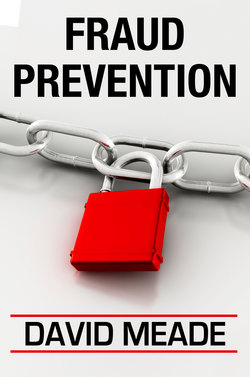Fraud Prevention

Реклама. ООО «ЛитРес», ИНН: 7719571260.
Оглавление
David Meade. Fraud Prevention
I. PREFACE
1. An Overview of Corporate Governance. II. Key Reasons We Need Corporate Governance
III. An Overview of Key Principles
IV. Strategies for Implementing
V. Information Systems – Cases & Controls
VI. Disclosure Requirements
VII. The Offshore Impact of Sarbanes-Oxley
VIII. Case Studies of Anti-Fraud Controls
IX. Controls to Prevent Fraud
2. Enron and Arthur Andersen: A Case Study. X. ENRON – A CLASSIC FRAUD – AN EXTENSIVE CASE STUDY OF THE REAL STORY
XI. Collapse of the Scheme
3. Cases of Note. XII. A Study of the Major Types and Classes of Corporate Fraud
XIII. The Federal National Mortgage Association Restatement
XIV. OMB Circular A-123
XV. The Health South Case
XVI. Backdating Stock Options: Sarbanes-Oxley Implications
XVII. Backdating Stock Options: Remediation
XVIII. Defending Against Class Action Suits
XIX. Corporate Governance
ABOUT THE AUTHOR
Отрывок из книги
The Sarbanes-Oxley Act of 2002 is the most major securities regulation to affect companies since the Securities Exchange Act of 1934. Right now there are about 15,000 listed companies, which have a total market value of approximately $37 trillion and are held by tens of millions of shareholders. Studies have indicated that 1 to 6% of all corporate revenue is lost to fraud. In my consulting practice I have developed close to one hundred templates that I use in protecting companies from the effects of fraud on their revenue stream.
The Enron trial ended after four years of federal investigations and 108 days of sworn evidence. The prosecution based its case on evidence provided by executives below the top level, who themselves took plea deals, and on the Watkins letter, which exposed the fraudulent activities of the corporation in August 2001. Judge Lake invoked a common feature in white-collar prosecutions by giving the “ostrich instruction” to the jurors. This allows the jury to find a defendant guilty if they had sufficient notice of problems (like the Watkins letter), but deliberately refused to recognize or act on that information. Former WorldCom CEO, Bernard Ebbers, was convicted by way of a similar ruling.
.....
The ostrich instruction is a common feature in white collar crime prosecutions. United States v. Jewell, 532 F.2d 697 (9th Cir. 1976), sets forth the classic instruction in this area: “You may infer knowledge from a combination of suspicion and indifference to the truth. If you find that a person had a strong suspicion that things were not what they seemed or that someone had withheld some important facts, yet shut his eyes for fear that he would learn, you may conclude that he acted knowingly.” Judge Posner explained how the ostrich instruction should be understood, and its limitations, in United States v. Giovannetti, 919 F.2d 1223 (7th Cir. 1990):
The most powerful criticism of the ostrich instruction is, precisely, that its tendency is to allow juries to convict upon a finding of negligence for crimes that require intent . . . The criticism can be deflected by thinking carefully about just what it is that real ostriches do (or at least are popularly supposed to do). They do not just fail to follow through on their suspicions of bad things. They are not merely careless birds. They bury their heads in the sand so that they will not see or hear bad things. They deliberately avoid acquiring unpleasant knowledge. The ostrich instruction is designed for cases in which there is evidence that the defendant, knowing or strongly suspecting that he is involved in shady dealings, takes steps to make sure that he does not acquire full or exact knowledge of the nature and extent of those dealings. A deliberate effort to avoid guilty knowledge is all the guilty knowledge the law requires.
.....